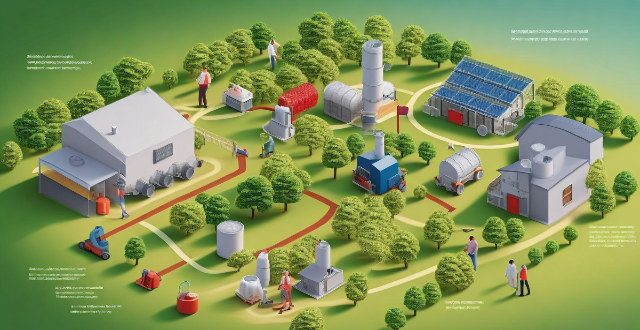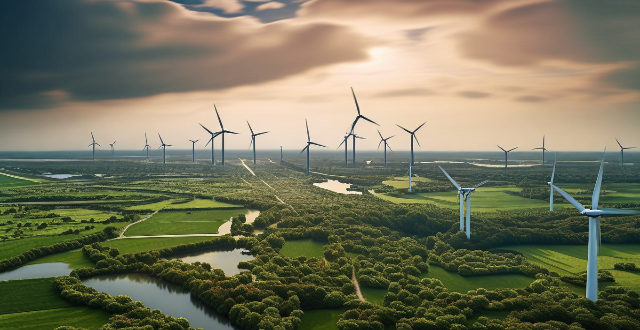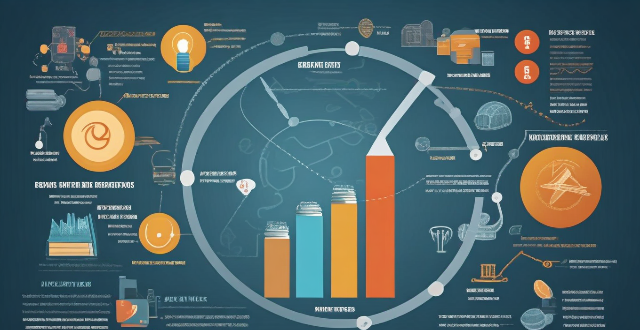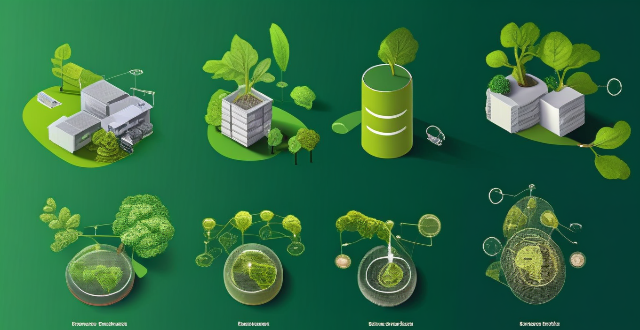Economic Renewable

What are the economic impacts of implementing renewable energy policies ?
Renewable energy policies have both positive and negative economic impacts, including job creation, energy cost savings, reduced emissions, higher upfront costs, intermittency issues, and land use concerns. As we transition towards a more sustainable future, it will be important to carefully consider these impacts and work towards finding solutions that balance environmental goals with economic realities.

What is the role of renewable energy in achieving climate commitments ?
Renewable energy is a key component of global efforts to reduce greenhouse gas emissions and mitigate climate change, contributing to environmental protection, economic prosperity, and social well-being. It reduces carbon footprint, enhances energy security, stimulates economic growth, improves public health, supports sustainable development, advances technology and innovation, and contributes to international cooperation. The transition to renewable energy is crucial for meeting climate commitments and ensuring a sustainable future.

What is the public opinion on renewable energy policies and their implementation ?
Renewable energy policies have garnered significant attention as global efforts to combat climate change intensify. Public opinion is divided, with proponents highlighting environmental and economic benefits, while critics focus on costs and reliability concerns. Key aspects include: - **Support**: Backed by concerns for the environment and economic growth through innovation. - **Opposition**: Arises from perceived high costs, market distortions, and questions about renewable energy's reliability. - **Implementation Challenges**: Include technological advancements, infrastructure needs, and the necessity for consistent political support. - **Public Participation**: Education and active community involvement are crucial for building consensus and effective policy implementation.

What is the impact of renewable energy on emission reduction goals ?
The shift to renewable energy sources such as solar, wind, hydro, and geothermal power is vital for reducing greenhouse gas emissions and achieving global emission reduction goals. This transition brings multiple benefits including decreased reliance on fossil fuels, improved air quality, enhanced energy security, economic stimulation through job creation and long-term cost savings, technological innovation leading to reduced costs, and significant contributions to mitigating climate change. As technology advances and economies of scale are achieved, renewable energy's role in facilitating further progress toward emission reduction objectives will become increasingly important.

What role do renewable energies play in achieving climate objectives ?
Renewable energies play a crucial role in achieving climate objectives by reducing greenhouse gas emissions, promoting energy security, and driving economic growth. By transitioning to renewable sources such as solar, wind, hydro, and geothermal power, we can reduce the overall carbon footprint of our energy systems and mitigate the effects of climate change. Renewable energies also promote energy security by diversifying energy sources, increasing local energy production, and stabilizing energy prices. Additionally, the transition to renewable energies creates job opportunities, stimulates innovation, and attracts investment, contributing to economic growth. Overall, prioritizing the development and adoption of renewable energy technologies is essential for achieving a cleaner, more sustainable future.

What role do pumped hydro storage systems play in renewable energy integration ?
Pumped hydro storage systems are crucial for renewable energy integration by offering reliable and efficient energy storage, balancing supply and demand, enhancing grid stability and reliability, facilitating higher penetration of renewables, providing ancillary services, and delivering economic benefits.

How does renewable energy contribute to reducing carbon emissions ?
Renewable energy is crucial for mitigating climate change by reducing carbon emissions. It displaces fossil fuels, lowers emissions intensity, improves energy efficiency, and reduces system leaks. Benefits include mitigating climate change, improving air quality, and offering economic advantages such as job creation and savings on fuel costs.

How can we balance economic growth with environmental sustainability ?
Balancing economic growth with environmental sustainability requires a multifaceted approach that includes promoting green infrastructure and renewable energy, encouraging sustainable business practices, fostering innovation and technology development, educating and engaging stakeholders, and implementing policies and regulations. By taking these steps, we can create a more sustainable future where economic prosperity coexists with environmental well-being. Achieving this balance will require ongoing effort from all sectors of society, including governments, businesses, communities, and individuals alike.

How do climate policies influence renewable energy development and adoption ?
Climate policies play a crucial role in shaping the trajectory of renewable energy development and adoption. These policies are designed to mitigate the effects of climate change by reducing greenhouse gas emissions and promoting the use of clean energy sources. In this article, we will explore the various ways in which climate policies influence renewable energy development and adoption. Governments around the world have implemented a range of incentives and subsidies to encourage the development and adoption of renewable energy sources. These include feed-in tariffs, renewable portfolio standards, tax credits and exemptions, and research and development funding. Carbon pricing mechanisms, such as carbon taxes and cap-and-trade systems, are designed to put a price on carbon emissions. By making fossil fuels more expensive relative to renewable energy sources, these policies create an economic incentive for businesses and consumers to switch to cleaner energy alternatives. Governments also impose regulatory measures to promote renewable energy development and adoption. These include building codes and standards, energy efficiency standards, and renewable energy targets. Public awareness and education campaigns aim to increase public awareness about the benefits of renewable energy and encourage its adoption. These campaigns promote energy conservation, support local renewable energy projects, and raise awareness about the environmental and economic benefits of clean energy sources.

What role do renewable energies play in the energy transition process ?
The role of renewable energies in the energy transition process is to help decarbonize the power sector, promote sustainability, provide economic benefits, improve energy security, and enhance public health. Renewable sources like solar, wind, hydropower, and geothermal emit little to no greenhouse gases during operation, making them crucial for reducing carbon emissions associated with electricity generation. These sources are also sustainable as they are replenished naturally and do not deplete over time. Investing in renewable energies can lead to job creation, technological innovation, and cost savings in the long run. By diversifying energy sources, countries can reduce their dependence on imported fuels and enhance their energy security. Additionally, renewable energies have lower environmental impacts than fossil fuels, leading to improved air quality and public health benefits.

What is the role of renewable energy in combating climate change ?
The text discusses the role of renewable energy in combating climate change. It defines renewable energy as derived from natural processes that are constantly replenished, including solar, wind, hydroelectric, geothermal, and biomass energy. The importance of renewable energy is highlighted by its low carbon emissions, sustainability, and economic benefits. Renewable energy combats climate change by reducing greenhouse gas emissions, diversifying the energy mix, promoting energy efficiency, stimulating innovation, and enhancing environmental stewardship. The transition to renewable energy presents economic opportunities and promotes innovation, with a profound impact on slowing climate change.

How do renewable energy policies vary across different countries and regions ?
Renewable energy policies globally are shaped by economic, environmental, and political factors. Europe leads in renewable adoption with Germany's Energiewende, Spain's feed-in tariffs (FiTs), and Denmark aiming for fossil fuel independence. North America uses state-level RPS, tax incentives, and market-driven approaches. Asia sees rapid growth with China's government support and India's ambitious targets. Africa focuses on access to electricity through projects like South Africa's REIPPPP. Latin America balances economic development and sustainability, with Brazil expanding into solar and Mexico deregulating its electricity market. Policies include FiTs, quota systems, auctions, and financial incentives, varying by region's resources and priorities.

What is the role of renewable energy in achieving carbon neutrality ?
Renewable energy is crucial for achieving carbon neutrality, which involves balancing carbon emissions with offsetting actions. By reducing reliance on fossil fuels and greenhouse gas emissions, renewable sources such as wind and solar contribute significantly to this goal. Renewable energy also promotes energy efficiency, economic growth, and energy independence while mitigating climate change impacts. It supports sustainable development goals and fosters innovation and public engagement in environmental issues. The transition to renewable energy offers long-term environmental benefits, making it essential for a sustainable future with stable climates, thriving economies, and healthier societies.

What impact do energy storage solutions have on the economics of renewable energy ?
Energy storage solutions significantly impact renewable energy economics by addressing variability and unpredictability. They enhance grid stability, reduce costs, and increase efficiency, thus making renewable energy more viable. With ongoing technological advancements, energy storage will continue to play a crucial role in integrating renewable energy into power grids and achieving global decarbonization goals.

What is the role of renewable energy in reducing greenhouse gas emissions ?
Renewable energy sources like solar, wind, hydro, and geothermal power are crucial in reducing greenhouse gas emissions as they produce significantly fewer carbon emissions than fossil fuels. These abundant and sustainable sources can be replenished naturally, creating a more sustainable future. Investing in renewable energy also brings economic benefits by decreasing technology costs and stimulating local economies. Renewable energy improves air quality by not producing harmful pollutants associated with fossil fuel combustion. It plays a vital role in mitigating the effects of climate change by reducing greenhouse gas emissions. By transitioning to a low-carbon economy powered by renewable energy, we can avoid the worst impacts of climate change.

What impact does decentralized renewable energy have on the electric grid ?
Decentralized renewable energy sources, such as solarDecentralized renewable energy sources, such as solarbines, have a significant such as solar panels and wind turbines, have a significant impact on the electric grid. They reduce dependence on centralized generation, affect grid stability and reliability, require infrastructure changes, have economic implications, provide environmental benefits, and empower communities. As technology advances and costs decrease, decentralized renewable energy is expected to be increasingly adopted worldwide, offering numerous benefits in terms of sustainability, development, and community control over energy sources.

How can developing countries benefit from implementing renewable energy solutions ?
Renewable energy solutions offer significant benefits for developing countries, including reduced energy costs, job creation, improved health and environmental quality, increased energy security, and climate change mitigation. By investing in renewable energy infrastructure, these countries can build more sustainable and prosperous futures for themselves and their citizens.

What steps can governments take to promote renewable energy jobs ?
Governments can promote renewable energy jobs through various policies and incentives. They can implement regulations like Renewable Portfolio Standards, Feed-in Tariffs, Net Metering Laws, and Renewable Energy Certificates. Financial incentives such as tax credits, grants, loans, and investment tax exemptions can also be provided. Governments can support research and development by funding studies, collaborating with academia, forming public-private partnerships, and supporting startups. Education and training programs, infrastructure development, streamlining permitting processes, encouraging local production and consumption, and international cooperation are other steps that can be taken to promote renewable energy jobs.

Can renewable energy sources help in reducing the impact of global warming ?
Renewable energy sources, including solar and wind power, can significantly reduce greenhouse gas emissions and contribute to a sustainable future. These clean energy alternatives offer benefits such as reduced carbon footprint, energy independence, and economic growth. However, challenges like intermittency, storage issues, and high initial costs need to be addressed through grid modernization, advances in storage technology, government incentives, and increased public awareness. By overcoming these obstacles, we can create a more sustainable future for all.

How can climate and environmental policies be designed to promote sustainable economic growth ?
This text discusses the integration of environmental considerations into economic planning, promoting renewable energy sources, encouraging energy efficiency, supporting green infrastructure, promoting circular economy practices, strengthening environmental regulations, and fostering international cooperation to promote sustainable economic growth.

What are the benefits of using renewable energy sources for improving energy efficiency ?
Renewable energy sources offer multiple benefits, includingRenewable energy sources offer multiple benefits, including improved air quality, cost savings Renewable energy also provides stable energy prices and reduces dependence on imported fossil fuels, leading to greater energy security. Additionally, the development and deployment of renewable energy technologies create jobs and drive innovation and research in new technologies. Overall, investing in renewable energy is crucial for a sustainable future.

How do renewable energy credits and incentives influence the adoption of green technologies ?
Renewable energy credits (RECs) and incentives are crucial for promoting the adoption of green technologies. They offer economic benefits to individuals, businesses, and governments investing in renewable energy sources, making these technologies more financially attractive. RECs represent proof of electricity generated from renewable sources, while incentives can include tax breaks, grants, rebates, and feed-in tariffs. These mechanisms reduce upfront costs, provide long-term financial benefits, enhance market competitiveness, drive innovation, and foster environmental stewardship. Overall, RECs and incentives are essential for accelerating the transition towards a sustainable energy future.

How can renewable energy policies be designed to maximize social and environmental benefits ?
Renewable energy policies are crucial for transitioning towards a sustainable future. To maximize social and environmental benefits, these policies must be carefully designed, considering various factors such as economic impacts, technological advancements, public acceptance, and environmental sustainability. Here's a detailed guide on how renewable energy policies can be structured to achieve the best outcomes: ## 1\. Setting Clear and Achievable Goals Clear objectives are fundamental for effective policymaking. These goals should be specific, measurable, achievable, relevant, and time-bound. ## 2\. Promoting Technological Innovation and Research Investments in research and development (R&D) are vital for advancing renewable technologies. Incentivize private sector R&D, provide public funding for research, and foster collaboration between academia and industry. ## 3\. Encouraging Public Participation and Awareness Engagement from the public is essential for the successful implementation of renewable energy policies. Educational campaigns, community involvement programs, and feedback mechanisms are key components. ## 4\. Implementing Economic Incentives Make renewable energy options more attractive through financial incentives such as feed-in tariffs, tax credits, and subsidies. ## 5\. Strengthening Legal and Regulatory Frameworks Establish clear regulations that support renewable energy adoption, including net metering laws, renewable portfolio standards, and building codes. ## 6\. Addressing Environmental Concerns Ensure that renewable energy projects minimize environmental impacts through environmental impact assessments, habitat protection measures, and sustainable land use practices. ## 7\. Supporting Infrastructure Development Invest in the necessary infrastructure to facilitate the growth of renewable energy, including transmission networks, storage solutions, and smart grids. ## 8\. Fostering International Cooperation Global collaboration is key to tackling climate change effectively. Facilitate the transfer of renewable energy technologies across borders, collaborate on international research efforts, and participate in treaties aimed at reducing carbon emissions and promoting renewable energy use globally.

How efficient is wind energy compared to other renewable sources ?
The efficiency of wind energy is influenced by factors such as capacity factor, technological advancements, and site specificity. Compared to other renewable sources like solar, hydropower, geothermal, biomass, and tidal/wave energy, wind energy has a relatively high capacity factor ranging from 35% to 45%. Technological improvements have increased the efficiency of wind turbines over the years, making them more productive. However, the efficiency of wind farms is highly dependent on the location, with optimal sites achieving higher efficiency rates. In conclusion, wind energy compares favorably to other renewable sources in terms of efficiency, but the choice between different renewable energies often depends on local conditions, economic factors, and technological advancements.

How can a carbon tax be used to encourage the development of renewable energy sources ?
A carbon tax is a fee on burning carbon-based fuels that aims to reduce emissions by making fossil fuels more expensive, encouraging the use of renewable energy sources. It directly impacts prices, changes consumer behavior, provides economic incentives for renewables, creates market signals for businesses, and supports regulatory frameworks. This leads to increased investment in research and development, subsidies, long-term planning security, innovation, and stricter efficiency standards, all of which contribute to the development of renewable energy sources.

How do climate commitments impact economic growth and development ?
The impact of climate commitments on economic growth and development is multifaceted, with both positive and negative aspects. On the positive side, these commitments stimulate innovation in renewable energy sources and energy efficiency, create new markets for green products and services, improve public health by reducing air pollution, and enhance international cooperation. On the negative side, there are transition costs associated with shifting from fossil fuels to renewable energy sources, potential job displacement in traditional industries, trade-offs between environmental protection and economic growth, and unequal distribution of benefits and costs. Despite these challenges, prioritizing sustainability can lead to long-term economic growth while protecting the environment for future generations.

What are the economic implications of enacting stringent climate change legislation ?
The article discusses the economic implications of stringent climate change legislation, which include job creation in renewable energy and green infrastructure sectors, potential increases in energy and food prices, new business opportunities in innovation and carbon trading, and investment in clean technology leading to economic growth. However, there are also short-term transition costs and job displacement issues. Despite these challenges, the long-term benefits such as improved air quality and increased resilience against natural disasters make the implementation of such legislation beneficial for future generations.

How do economic systems contribute to environmental problems and climate change ?
Economic systems, especially capitalism and industrialization, significantly impact the environment by promoting overproduction, waste, and reliance on fossil fuels. Issues such as built-in obsolescence, global trade emissions, and exploitation of natural resources exacerbate environmental problems. Additionally, population growth and urbanization increase consumption, while market failures and regulatory gaps often overlook environmental costs. Addressing these challenges requires a shift in economic priorities towards sustainability.

Can hydroelectric power be considered a renewable energy source ?
Hydroelectric power is often considered renewable due to its reliance on the water cycle, but debates exist over its classification. Advantages include being a renewable resource, having low emissions, and providing energy storage. Disadvantages involve ecosystem impacts, community displacement, and siltation/erosion issues. The definition of "renewable" influences whether hydroelectric power is seen as truly renewable, with varying priorities leading to differing conclusions.

What is the current state of renewable energy research and development ?
Renewable energy research and development (R&D) is a rapidly evolving field that aims to create sustainable alternatives to traditional fossil fuels. The current state of renewable energy R&D can be characterized by several key trends: ### **Advances in Technology** - Solar energy research focuses on improving the efficiency of photovoltaic cells and concentrated solar power systems. - Wind energy technology is advancing with the development of offshore wind turbines and material innovations for turbine blades. - Hydropower research explores ways to harness energy from small streams and rivers without ecological harm, as well as improvements to pumped storage systems. - Geothermal energy is expanding beyond natural hotspots through enhanced geothermal systems and binary cycle power plants. ### **Integration with Grid Systems** - Smart grids enable better management of consumer demand and integrate distributed energy resources like rooftop solar panels and small wind turbines. - Energy storage solutions, such as battery technologies and pumped hydro storage, are being refined for improved efficiency and environmental impact. ### **Policy and Economic Drivers** - Government incentives like tax credits and feed-in tariffs encourage renewable energy adoption. - Carbon pricing mechanisms, including emissions trading schemes and carbon taxes, create financial incentives for companies to reduce their greenhouse gas emissions. ### **Environmental Impact and Sustainability** - Lifecycle analysis examines the manufacturing processes and end-of-life management of renewable energy equipment to minimize environmental footprint. - Biodiversity conservation efforts aim to mitigate the impact of renewable energy infrastructure on wildlife habitats and ecosystems. As technological innovation, grid integration advancements, supportive policies, and consideration for environmental impact continue, renewable energy is expected to play an increasingly vital role in global energy supply while helping to mitigate climate change.